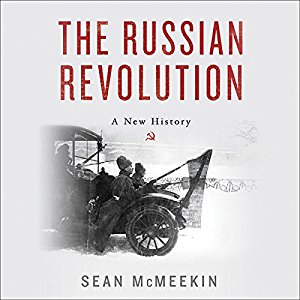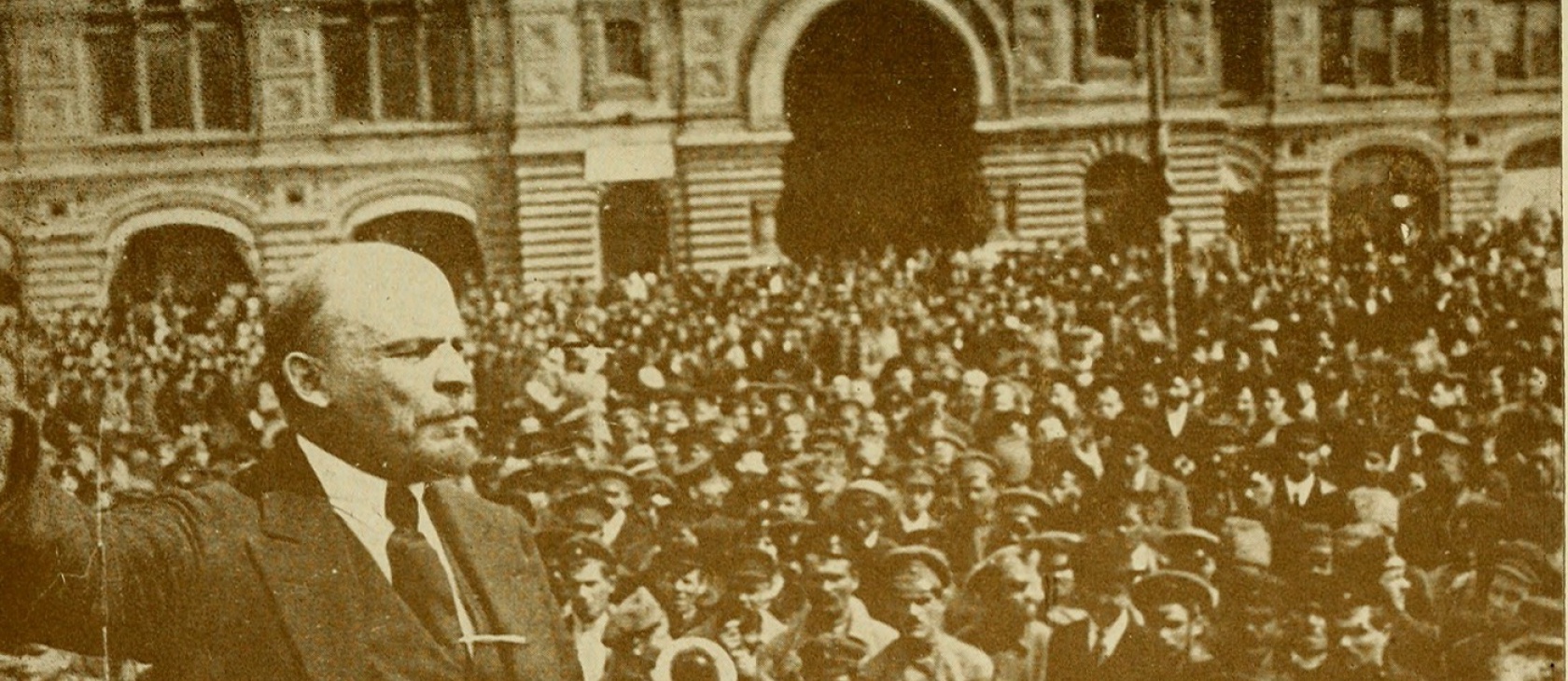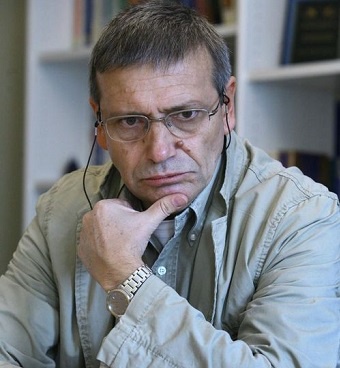The Russian Revolution: a New Story. Sean McMeekin.
New York: Basic Books, 2017. 496 pages.
I am writing this review of in a downtown Moscow hotel, on the eve of the 100th anniversary of the Russian Revolution – and around me there are no signs of glorification, celebration, or even remembrance of the grave events of 1917. Even public officials are shy of commemorating that part of the country’s history. According a friend, Andrey Kolesnikov who is a Senior Fellow at the Carnegie Moscow Center, the reason for such behavior is very simple:
The Revolution is “irrelevant” because “the generations that still had romanticized notions about [it] are departing, and the number of respondents who believe that “the early years after 1917 brought more bad than good” consistently grows: it went up by 10 percentage points from 1994 (38 percent) to 2016 (48 percent).”
There are other bits of contemporary history, shown in a poll from the Levada Center, which constitute the national pride of contemporary Russians. What makes Russians proud is the actions of the imperial nineteenth century, the conquering of vast lands in Europe to the Far East, and what is, in their mind, the correction of history with the retaking of Crimea in 2014 (of which almost 80 percent of Russian citizens are proud).
Besides North Korea, the Russian Federation is the only openly aggressive country in the Northern  hemisphere. Forgetting the Russian Revolution as an inconvenient past is an important factor stoking the aggressive behavior of Russia’s present leadership.
hemisphere. Forgetting the Russian Revolution as an inconvenient past is an important factor stoking the aggressive behavior of Russia’s present leadership.
The revolution, once labeled in schools from Vladivostok to East Berlin as the “Great October Socialist Revolution,” was inglorious. It proved deadlier than the World War I to the Russian empire. It provoked or inspired all the major disasters of the twentieth century. The world must never forget it and, among the vast literature on the October Revolution, Sean McMeekin’s book The Russian Revolution: a New Story builds a monumental panorama of both its accidental nature and bloody, historic significance.
McMeekin stands on the shoulders authors such as Richard Pipes and Orlando Figes, but he also elaborates on his own academic record, having already published four books on the Bolshevik looting and propaganda war, on the impact of October 1917 on reshaping of the Middle East, and on World War I. All these books were published from 2001 to 2008.
Establishing a successful revolutionary model
Besides panoramic vision, McMeekin shows an extraordinary sense of detail and thus helps the reader draw parallels between Bolshevik “innovation” and practical details of modern-day hybrid warfare as practiced by President Putin and his regiment of KGB collaborators.
After Louis Fischer’s biography of Lenin in 1964, it is well known that the Bolshevik group that came to control that vast country after October 1917, and after the World War II created the Soviet sphere of influence over approximately 40 percent of the territory of the earth, was financed and smuggled into Russia by German authorities. McMeekin’s account of this episode puts the particulars (discovered earlier by Fisher, Pipes, and Shapiro) together, showing how this investment of five million gold Marks in Lenin paid enormous dividends for the Germans. These came, first, in war gains and Russia’s capitulation before the Central Powers (Germany, Austria-Hungary, Bulgaria, and the Ottoman Empire), in March 1918.
The Communists created a propaganda machine second to none. It spurred waves of soldiers to desert the war front, then undermined the efforts of Kerensky’s government to introduce a legitimate constitutional order in post-Tsarist Russia. Lenin’s attack on legitimacy was so extreme that in April 1917 even his party newspaper, Pravda, refused to publish his program. Lenin’s response was to purchase the paper and a state of the art printing facility, and increase its circulation in the army.
McMeekin chronicles the Bolsheviks’ destruction of any legitimacy. Its first victim were the Soviets, the workers councils. Their Central Executive Committee (elected in June 1917) was dismissed for collaboration with Kerensky. At the Second All-Russia Congress of Soviets of Workers' and Soldiers' Deputies, Lenin’s group seized power without elections; the elections for a Constituent Assembly were scheduled for November 12.
In his appeal to the Congress, Lenin promised: “immediate democratic peace to all the nations and an immediate armistice on all fronts”; a “transfer of the land of the landed proprietors, the crown, and the monasteries to the peasant committees without compensation”; “complete democracy in the army” (to protect “soldiers’ rights”); and to “establish workers' control over production.” The new Soviet government, Lenin said, is a provisional government of sorts, to “ensure the convocation of the Constituent Assembly at the time appointed.” He added that “it will see to it that bread is supplied to the cities and prime necessities to the villages; it will guarantee all the nations inhabiting Russia the genuine right to self-determination.”
The first task this government pursued ahead of these elections, however, was to ban the non-Bolshevik press and persecute the liberal Constitutional Democratic Party. It also enforced the “fullest freedom of agitation” for peace in the army and it sought that “the right of private ownership of land is abolished forever,” dividing the arable land “among toilers in accordance with the consumption-labor standard.” The latter standard had not been and could never be calculated. The decree aimed at neutralizing the influence of Socialist-Revolutionary (SR) Party, which promised to give the land to the peasants.
Among the vast literature on the October Revolution, Sean McMeekin’s book The Russian Revolution: a New Story builds a monumental panorama of both its accidental nature and bloody, historic significance.
Besides the harassment, the Bolsheviks lost the elections for Constituent Assembly, winning only 24 percent of the vote. The remaining 76 percent went to other parties, the largest faction (40 percent) going to the SR Party. So, the Bolsheviks’ next move was not to summon the Assembly.
But even before the elections, “the world’s first proletarian government was … forced to devote its primary energies to strikebreaking,” because on October 28 railway workers went on strike. By November 7 (on the Julian calendar) they were joined by telegraph and telephone, ministerial servants, and (non-unionized) bank employees, and the strike became general. The banks were shut first on October 26; Sean McMeekin describes how “the most stubborn resistance came from the banking community.” (See pages 219-223.) The bank clerks were determined to protect the assets of their clients and resisted the soldiers “looking for money” in the vaults of the banks for about 20 days, until the troops were ordered by Lenin to take hostages. The bank directors bargained the ransom from the one billion rubles first requested down to about five million. The boycott of 6,000 bank clerks in Petrograd alone continued irrespective of the hostage taking until mid-December, when the private ownership of banks was abolished and the saving of anything more than 10 months’ wages was appropriated by the “Commissar for Formerly Private Banks.” The confiscated amount totaled between 1 and 1.5 billion rubles, or $150 billion (U.S.) today.
This was the laboratory out of which the All-Russian Extraordinary Commission to Combat Counterrevolution, Speculation, and Sabotage was born, on December 7. This is the infamous Cheka, NKVD, or KGB, a legacy of which is the Federal Security Service (or FSB) in contemporary Russia.
The Russian Revolution is typically portrayed as the inevitable result of incompetent tsar, war, war-related hunger, and unfinished industrialization. Summarizing the newly opened archives and the work of the forerunners in the history of October 1917, McMeekin demonstrates that many events, and even purely personal circumstances, could have changed the course of these tragic events.
The Big Picture
The pre-Revolution famine that came as a result of war was insignificant, not only in light of the previous Russian – and certainly future Soviet – experience, but in terms of economic statistics. Grain shortages happened occasionally, most often an outcome of logistical distortions of the war. In 1917, Russia had a surplus of grain and stopped exporting it to meet domestic demand. The real famine hit the country with the Red Terror of the Cheka, after the Bolsheviks attempted to abolish private property and nationalized banks, industries, and land. The bread production level plummeted in 1918 with the onset of the civil war, and was further decimated by the dry summers and winters of 1920 and 1921. The peak of hunger hit Russia in mid-1921. The civil war in some ways was an amalgamation of peasants’ revolts due to requisition and food rationing in the cities. Some authors count about 4,000 such local revolts, and vast territories were controlled by gang chieftains supported by the population for the simple hope of protection. Scarce resources were in the same years spent on luxury food imports for the cities – first of all, for Communist Party elites. When the hunger struck the provinces in July 1921, Lenin ordered “to provide the food agencies [with] the total power of the state apparatus of coercion.”
McMeekin describes how “the most stubborn resistance came from the banking community.” The bank clerks were determined to protect the assets of their clients and resisted the soldiers and marine troops “looking for money” in the vaults of the banks for about 20 days, until the troops were ordered by Lenin to take hostages.
However embarrassing it may seem, the 1921 famine was softened by international aid provided first of all by the United States. When Lenin called for “bolstering food collection,” it was Herbert Hoover, then the U.S. secretary of Commerce and leader of the American Relief Administration (ARA), who was already providing food aid to Belgium and Hungary. Fueled by $60 million from Congress and donations from the Red Cross, Quakers, and the Federal Council of the Churches of Christ in America, ARA volunteers managed to feed 11 million Soviet subjects in 1921. The death toll was still beyond any imagination – five million perished – but the starvation was virtually over by the spring of 1922. Lenin’s response was to infiltrate ARA with Cheka agents who had English language proficiency and to set a Communist Youth-sponsored Friends of Soviet Russia operation in New York. It collected $125,000, of which it spent $73,000 on its own administration and propaganda against the ARA.
This story was not over: The 1921 famine was utilized by the Bolsheviks – on Lenin’s and Trotsky’s initiative – to fulfill the promise to put the monasteries “under peasants’ and workers’ control.” In fact, Lenin hoped that the looting of churches would bring to the government “several hundred million gold rubles.” Trotsky coined the slogan “turn gold into bread,” to motivate the operation. McMeekin gives a detailed account of the “success” 40 million gold rubles ($20 million U.S. at the time). It is anybody’s guess how much as appropriated by the enforcers. Lenin hoped for 99 percent success in implementing the commissars’ (secret) decree “On Liquidation of Church Property,” issued on January 2, 1922. He defined success as “shattering the enemy and assuring our position for decades.” He planned to settle Russia’s foreign debts with the coveted funds. We know that this plan did not materialize, but thousands of churches were destroyed. By 1922, 28 Orthodox bishops and no fewer than 1,200 priests were executed. Many more were forced leave Russia or were sent to the Gulag. McMeekin excels in telling this heart-wrenching story in his book.
The Legacy
The question remains: Why did this anti-human regime come to control Russia and later dominate the world’s Communist sphere? The author does not give a definite answer, but the book helps the reader think and further investigate the history of the Russian Revolution.
One of the answers is, perhaps, rather prosaic: The Soviets managed to appropriate roughly half of the Russian empire’s gold reserves, estimated at 1,300 tons in 1913 and around 1,000 tons in 1917. With 500 tons gold bullion, McMeekin finds, “Bolsheviks were liquid buyers.” Their supplies to the Red Army (6 million in 1920) and Cheka (280,000) were uneven in the first year-and-a-half of the revolution but resumed to exceed their rivals’ quality of ammunition, dress, and pay. In the book, one can read that some of the gold was spent on the lavish lifestyle and luxury goods of the Communist Party’s top brass. Lenin’s Rolls Royce (confiscated from one of the dukes) and the black leather jackets of Cheka uniforms were a priority. Rival White armies in the civil war had no such gold reserves. Often their commanders were bought off to lead or train the Red Army. An almost equal amount of gold fell under the control of Admiral Kolchak’s army, but as a gold in private hands, it required a massive discount before it could become liquid, to purchase necessary supplies. (McMeekin’s small section of the book, on “Kolchak’s gold,” is perhaps the weakest in terms of research. The full account of the fate of that gold may be found in Oleg Budnitskii, Money of the Russian Emigration: Kolchak’s Gold, 1918-1957. Moscow: Novoe literaturnoe obozrenie, 2008.)
The famine destroyed the reserves of the Soviets' anarchic opposition. By 1921, the Soviets were in full control of a territory almost twice the size of Europe, physically. Simultaneously, governments and individuals of free countries of the world cooperated with Kremlin and either made frozen imperial assets available to the Bolsheviks (e.g., Sweden and Germany in 1918 and 1919), or de facto lifted the trade embargo on Communist Russia as it happened in March 1921, at the peak of the Red Terror and the Kronstadt massacre spearheaded by Trotsky, under the initiative of Lloyd George. By the end of that year Austria, Czechoslovakia, Finland, Germany, Italy, and the Baltic States, plus Sweden and Norway, had already formalized their trade agreements with Lenin’s government.
As radical as they were, the Bolsheviks were at the beginning a very small group, so small that others did not pay attention to them. But they were bold, intolerant, and despised any limitations imposed by morality, religion, democracy, and public honor. They clearly violated their promise to provide for the self-determination of the peoples in Russia and in neighboring countries. Instead, they were bold in motivating their followers in the Communist International (the Comintern) to repeat their political modus vivendi in other countries of Europe, especially with their gold reserve. With stolen assets, they financed radical socialists from across Europe to follow a three-step course of action: to favor a military rather than parliamentary course of action, distinguish themselves from collaborative Social Democrats, and abandon national causes by instead following the international Communist agenda (i.e., become subject to the Comintern).
On the aftermath of WWI, this strategy paid off. Red Soviet republics were attempted in Germany and Hungary. Austrian left-wing radicals had a greater armed force than the police and the army of the state. Bulgaria and other Balkan countries saw radical Communist-sparked insurgencies financed by the Comintern. This policy led to splits between the Left in Germany, and thus helped Hitler’s Nazis political and electoral success (itself, in part, a radical reaction to the Communist threat). After WWII, virtually all European Communist countries followed the pattern of the October Revolution with the support of the Red Army.
Readers of this book can draw their own list of lessons from the Russian Revolution. The author concludes his new history with a clearer picture of the specter of Communism that haunted the twentieth century, and which displays itself even today.




